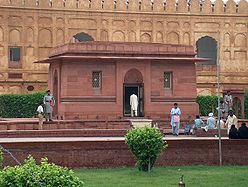- Tomb of Muhammad Iqbal
-
Tomb of Muhammad Iqbal (Urdu: مزار اقبال ; Mazaar-e-Iqbal) 
Mausoleum with Badshahi Mosque in the backgroundGeneral information Type Mausoleum Architectural style Mughal Location  Lahore, Pakistan
Lahore, PakistanDesign and construction Architect Nawab Zain Yar Jang Bahadur The Tomb of Allama Muhammad Iqbal is a simple but impressive structure located in Lahore, Pakistan in the Hazuri Bagh lawn between the Badshahi Mosque and the Lahore Fort where both the grand structures (the Mosque and the Fort) face each other.[1] Official guard is maintained by Pakistan Rangers. The architecture reflects a combination of Afghan and Moorish styles and is entirely constructed of red sandstone.[2] Hundreds of visitors come to the mausoleum every day to pay their respects to the poet-philosopher.[3]
He was one of the major inspirations behind the Pakistan Movement, and is revered in Pakistan as Muffakir-e-Pakistan (The Thinker of Pakistan) or Shair-e-Mashriq (The Poet of the East).[4] Iqbal died on April 21, 1938 in Lahore at the age of 60. Since the independence of Pakistan, an academy named after him (Iqbal Academy) has been established to promote and disseminate his poetical and philosophical messages and teachings. As another tribute, the recently renovated Lahore airport has also been named after him as Allama Iqbal International Airport.
Contents
Structure
The rectangular structure of the mausoleum has two gates at the eastern and southern side respectively, inlaid with marble. The grave is built of white marble. The tombstone is made of lapis lazuli and inscribed with Quranic verses in calligraphy. The tombstone was a gift from the people of Afghanistan. On the inside walls, six couplets of a ghazal are carved from Iqbal's peotical work Zabur-e-Ajam (Persian Psalms).[5] Outside, there is a small garden, distributed into small plots. The mausoleum was designed by Hyderabad Deccan’s then Chief Architect, Nawab Zain Yar Jang Bahadur and took thirteen years to build at a cost of about one hundred thousand (Rs.100,000) Pakistani rupees. The major reason for delay was the stoppage of red-stone from Jaipur in post-independence India.[6]
Design and construction
Soon after Iqbal’s death in April 1938, a committee was formed that was presided over by Chaudhary Mohammed Hussain.[7] The initial round of the designs submitted by distinguished architects was not satisfactory. The committee suggested to innovate a new combination rather than following a specific school of architecture. The final design, thus, broke away from Mughal tradition and comprised a combination of Afghan and Moorish architecture.
Funding issues
Apart from many other difficulties, the major problem was an arrangement of adequate funds. The committee resolved not to accept any donations from the local governments and state rulers as it would not be befitting homage. The funds were raised through the contributions from Iqbal’s friends, admirers and disciples.[8]
Construction materials
Red sandstone was brought from Jaipur and building marble from Makrana, Rajputana. After independence, the construction process was affected due to export restrictions of red stone from India. Lapis lazuli for the tombstone, the same as used for Mughal Emperor Babur’s tomb, was received from the people of Afghanistan as a gift. Couplets and Quranic verses were selected, calligraphed and inscribed in Afghanistan.
Every year the mausoleum attracts a number of dignitaries, notables, and Muslim countries delegations, members of diplomatic corps, who pay their homage. It is said that Mustafa Kemal Atatürk sprinkled the earth from Maulana Rumi’s tomb on his grave.[6] Every day a large number of people visit the national poet’s tomb, offer fateha and sprinkle flowers.
Gallery
-
Allama Iqbals Tomb East
South East side of the mausoleum
-
Guard at the mausoleum, with Lahore Fort in background
See also
- Architecture portal
- Iqbaliat
- Category:Iqbal scholars
- List of mausolea
References
- ^ Masudul Hasan, A Guide to Lahore, Ferozsons, 1978. p.18
- ^ Mohammad Waliullah Khan, Lahore and Its Important Monuments, Department of Archaeology and Museums, Government of Pakistan. 1964. p.89-91
- ^ Mushirul Hasan, H., A Nationalist conscience: M. A. Ansari, the Congress and the Raj, Manohar New Delhi. 1987
- ^ Annemarie Schimmel, Muhammad Iqbal 1873-1938: The Ascension of the Poet, Die Welt des Islams, New Ser., Vol. 3, Issue 3/4. 1954. pp. 145-157
- ^ Annemarie Schimmel,Islam in the Indian Subcontinent (Handbuch Der Orientalistik), Brill. 1980. ISBN 978-9004061170
- ^ a b Iqbal’s final resting place, Amna Nasir Jamal, 20 April 2002, Dawn
- ^ Muhammad Baqir, Lahore, Past and Present. University of the Panjab. Panjab University Press. 1952. p.429
- ^ A great eastern poet, philosopher, Subhash Parihar, The Tribune India, 10 July 1999
External links
Lahore topics History Origins • Etymology • Hindu rule • Muhammadan period • Mughal rule • Sikh rule • British rule • Lahore Resolution • 1965 War • Lahore DeclarationGeography Economy Stock market • Water supply and sanitation • Transport • Health care • Education • Tallest buildings • Sister citiesCulture Architecture • Cinema • Cuisine • Festivals • Language • Music • People • Religion • Shopping • SportsPlaces Category • Commons Categories:- Architecture of Lahore
- Mausoleums in Pakistan
Wikimedia Foundation. 2010.




